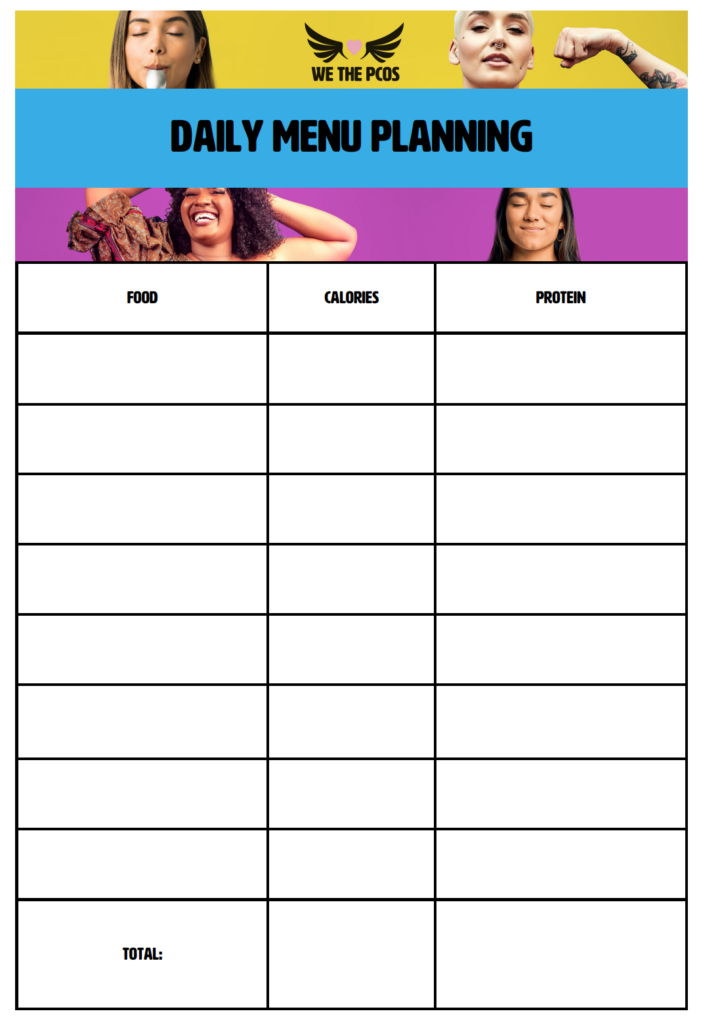To make things as simple as possible, we recommend only tracking two things:
- Calories
- Protein
Don’t worry. You’ll get plenty of fats and carbs. You just won’t track them. We have created quite comprehensive food lists divided into the following categories:
- Daily Foods
- Sometimes Foods
- Treat Meal Foods
The 3 simple steps to meal planning for PCOS are:
- Eat primarily from the ‘Daily Foods’ list, adding ‘Sometimes Foods’ in sparingly.
- Eat at a calorie deficit while hitting your protein goals.
- Structure your meals sensibly.
For the average height woman: we recommend 1500-1800 daily calories for PCOS fat loss. You can figure out your recommended calorie deficit & protein goals here. Our advice will serve the average woman, but please defer to your doctor or nutritionist’s advice above ours. Below is a quick reminder chart of how to structure your meals. Check out the full guide here.
| Meal | Lean protein + any ‘Daily Foods’ |
| Meal | Lean protein + Veggies |
| Meal | Lean protein + Veggies |
| Snack | Lean protein + any ‘Daily Foods’ |
Writing out your PCOS Meal Plan step-by-step.
We have a lovely, downloadable Menu Planning form to help you plan out your meals. But honestly you really just need any old piece of paper. Here’s how simple it is.
- Sit down with your Daily Menu Planning paper.
- Choose the breakfast, lunch, dinner, and snack you want to eat in the first column.
- Write in how many calories and protein grams each food contains in the respective columns next to each food item.
- Total the calories and protein grams at the bottom of the page.
- If your calories are within your allowance and you’re getting enough protein, you’re good to go. If not, adjust your food choices until the numbers work.
You can also use any reputable calorie tracker like Calorie King or MyFitnessPal. And of course, you can always consult food labels. The USDA has a very reliable nutrition tracker.
PCOS Menu Planning tips
- Always start with protein. You’ll need to have protein at every meal to hit your recommended protein goals. Protein helps you feel full longer. Get it in there. 🙂
- Next add veggies. Our suggested meal structure recommends a large serving of veggies with at least 2 meals per day. We find this works best with lunch and dinner.
- A good way to get protein in at breakfast is via egg whites, either in the pan or mixed into a recipe. Adding protein powder to oats or smoothies is another way to get the day kicked off right with a big helping of protein. Yogurt and breakfast meats are another way to go. Just be sure you’re eating primarily from the ‘Daily Foods’ list.
Menu planning for PCOS just takes a little practice and a good PCOS-friendly, low-GI recipe library. Luckily, we’ve got that. You can do it!
More PCOS Weight Loss Resources
Check out our YouTube Channel for supportive videos weekly on PCOS Nutrition, PCOS Inspiration, PCOS Training, PCOS Mental Health, and PCOS Accountability.


